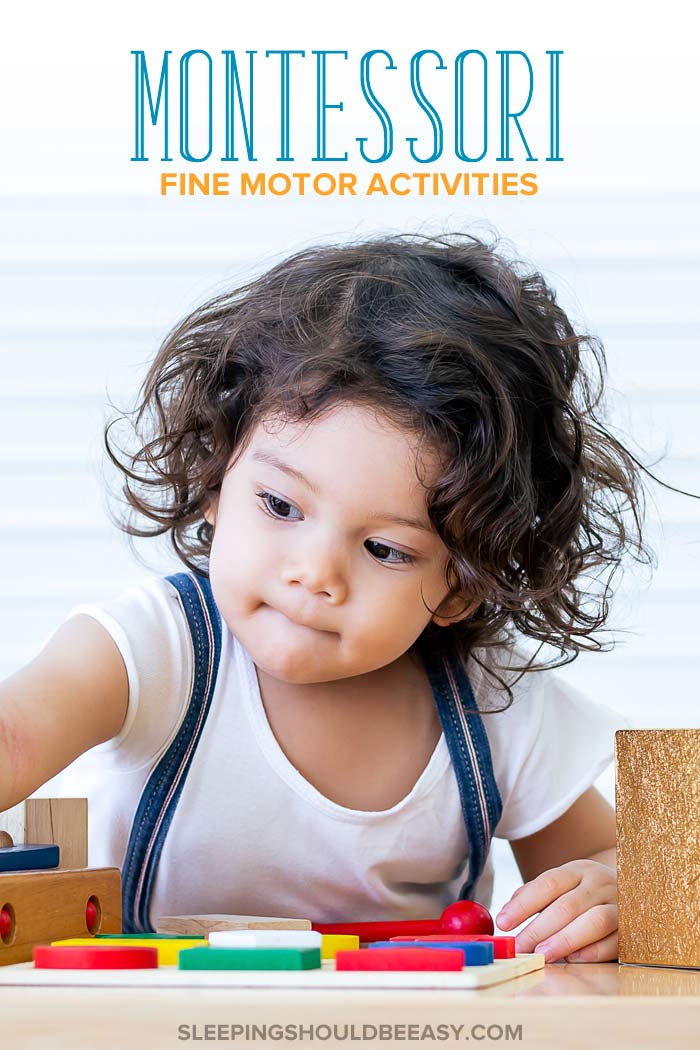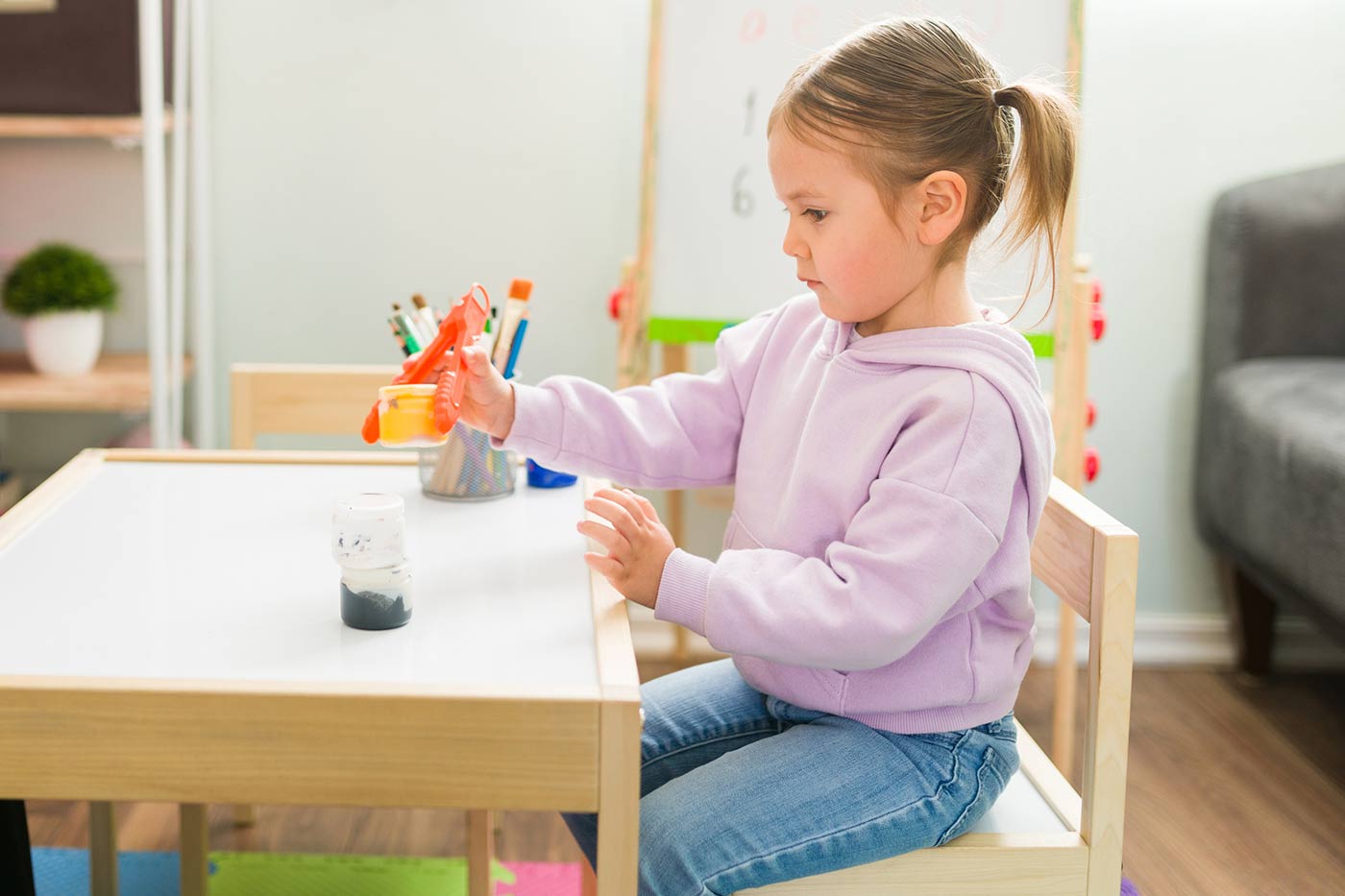No-Fuss Montessori Fine Motor Activities
Check out these Montessori fine motor activities for toddlers and preschoolers! Perfect to do at home, and includes household items and toys.
 Adjusting to his new Montessori preschool was a challenge for my then-toddler. Going from having one caregiver to himself to sharing a teacher with other children was no easy task.
Adjusting to his new Montessori preschool was a challenge for my then-toddler. Going from having one caregiver to himself to sharing a teacher with other children was no easy task.
But one activity that helped ease the transition—especially during school drop offs—was the “practical work” he’d do each morning. From pouring water to tweezing pom poms, these activities would make the start of the school day much easier.
Not only did he enjoy these practical life activities, he was also working on a critical skill during this stage: developing his small muscles and pincer grasp.
Table of Contents
Montessori fine motor activities
I enrolled my kids in a Montessori preschool because I love so many of its principles.
Adults respect each child’s individuality, allowing kids to develop at their own speed. Teachers understand that kids should have the freedom and self-discipline to work. And that we can create an environment where a love of learning can unfold and flourish.
We can apply these principles as we nurture the development of fine motor skills. These skills advance the small movements in the hands, fingers, and arms (combined with eye coordination). You’re honoring your child’s development and self-sufficiency, and helping her use her arm and hand muscles.
These Montessori fine motor activities are perfect for toddlers and preschoolers, and can be done using simple items at home. I hope you’ll be inspired by these ideas!
Opening and closing
- Open and close doors. Using door knobs and locking and unlocking doors can help your child use his hands and fingers.
- Open and close small containers. Give him a variety of containers, like small jars he can turn or empty makeup containers that snap open and close. Other ideas include small jewelry bags with a button, or Velcro pockets.
- Turn pages of a book. The next time you read to him, have him turn the pages.
Art and writing
- Color on coloring pages, especially characters or drawings your child loves.
- Tear construction paper, then glue it onto a blank sheet using glue sticks to make a collage.
- Write with pencils or colored pencils.
- Paint with a paint brush or sponge.
- Trace letters and numbers.

Free printables: Help your child trace and recognize letters and numbers with sample worksheets! Join my newsletter and grab them below—at no cost to you:
Self-sufficiency
- Washing hands. Encourage your child to wash his hands on his own, from turning the faucet to drying his hands.
- Brushing teeth. Have him squeeze the toothpaste onto the brush, fill his cup, and brush his teeth.
- Using buttons and zippers. Start with simple buttons like snap-ons before advancing to more complicated ones that loop through a hole. Then, teach him how to use zippers, like the ones on pants or backpacks.
Eating
- Eating finger foods. Encourage your child to feed himself, especially finger food with different textures.
- Peeling fruits. Even if you have to start it off for him, have him peel his own fruits, like mandarin oranges and bananas.
Putting things in
- Cheese shaker and toothpicks. Have your child pick up each toothpick and slip it through the holes of a cheese shaker. Don’t have a cheese shaker? You can use an upside-down colander.
- Snacks and containers. Put cereal or other similar snacks one at a time into a small container.
- Fabrics and wipes containers. Stuff fabric pieces (ribbons, socks, small burp cloths) into empty wipes containers.
Stringing
Disclosure: This article contains affiliate links. As an Amazon Associate, I earn from qualifying purchases.
- Beads and string. Tie a knot at the end of the string or yarn. Then, have your child slip a bead through the string. You can then tie the ends to turn it into a necklace.
- Pasta and a shoestring. Another alternative is to use dried pasta like penne or rigatoni. You might not be able to tie a knot big enough to stop the pasta, so put play dough at the end of the string, or tape one end to the table or tray while he works.
- Lacing toys. Get lacing cards like these to practice stringing through holes. This can also be fantastic practice for tying laces!
Play dough
- Roll play dough into long strips.
- Cut play dough using play dough scissors.
- Pinch pieces of play dough.
- Use a small roller to flatten a ball of play dough.
Pom poms
- Use large tweezers or tongs to move pom poms or other small objects from one bowl to another.
- Push pom poms inside a whisk.
- Put pom poms into a small jar like an empty spice container.
- Sort pom poms (or even beads or rocks) by color into empty ice trays.
Check out these fine motor skills activities for 4-5 year olds.

Toys
- Building blocks. Standard wooden blocks and cubes or easier-to-snap Bristle Blocks or Magnet Tiles can help your child use his hands.
- Play with puzzles. This not only helps with learning to piece items together, but encourages him to use his hands as well.
Water play
- Pouring water. Grab a measuring cup and two large bowls. Have your child dip the measuring cup into one bowl full of water, and pour it into the empty one. (You can do the same with dried beans or rice.)
- Basting. Grab a baster or dropper and two small bowls. Fill one bowl with water and the leave the other empty. Have her squeeze water out of the first bowl with the baster, and squeeze it into the empty bowl.
- Squeezing with sponges. The same idea here: fill a sponge with water from one bowl, and squeeze it into the empty one.
- Toy car wash. Have her clean toy cars with a toothbrush and soap in a bin of water.
Conclusion
Developing fine motor skills is an important and continuous milestone for kids. Practice these Montessori fine motor activities and honor your child’s individuality and self-discipline.
From playing with water to threading beads and even to eating finger foods, fine motor activities have never been more fun!
Get more tips:
- Montessori Activities for 1-2 Year Olds
- 7 Useful Ways to Teach the Montessori Alphabet
- How to Encourage Fine Motor Skills for 6 Year Olds
- Fine Motor Skills Activities for 5-6 Year Olds
Don’t forget: Join my newsletter and grab your sample worksheets below—at no cost to you:

